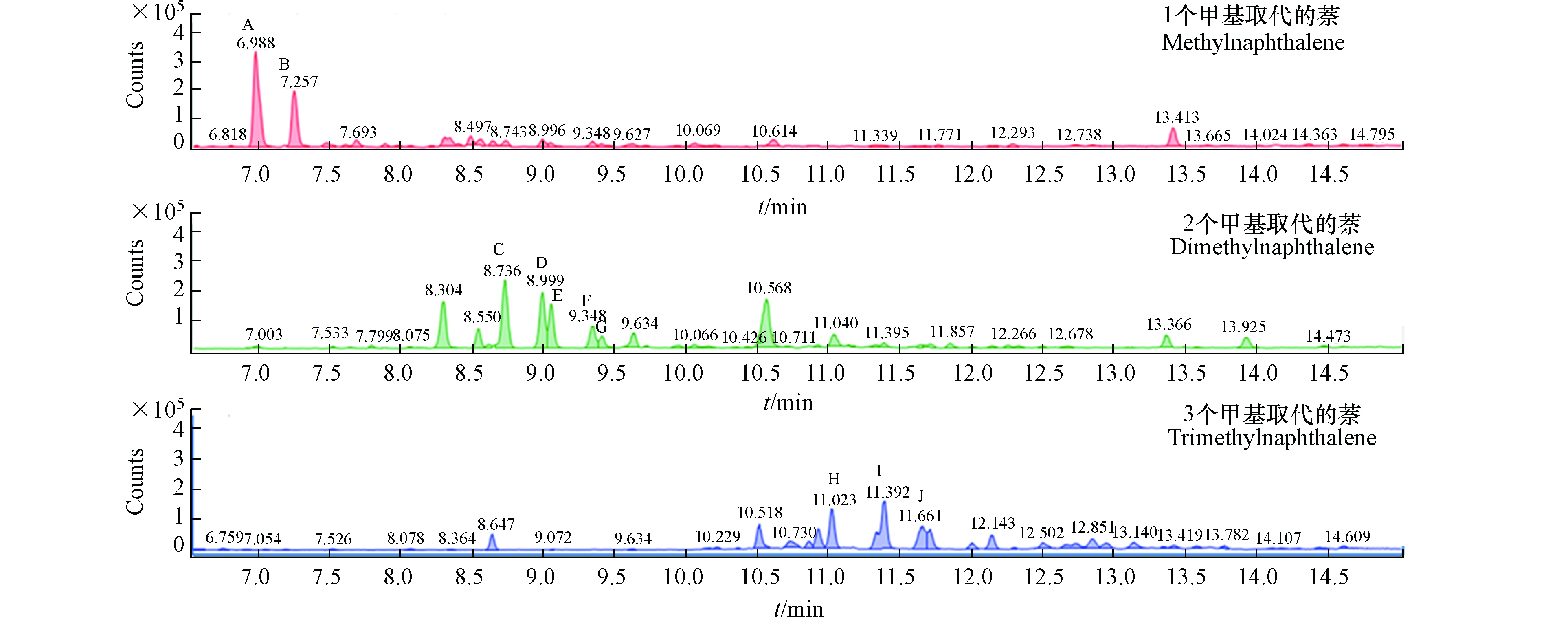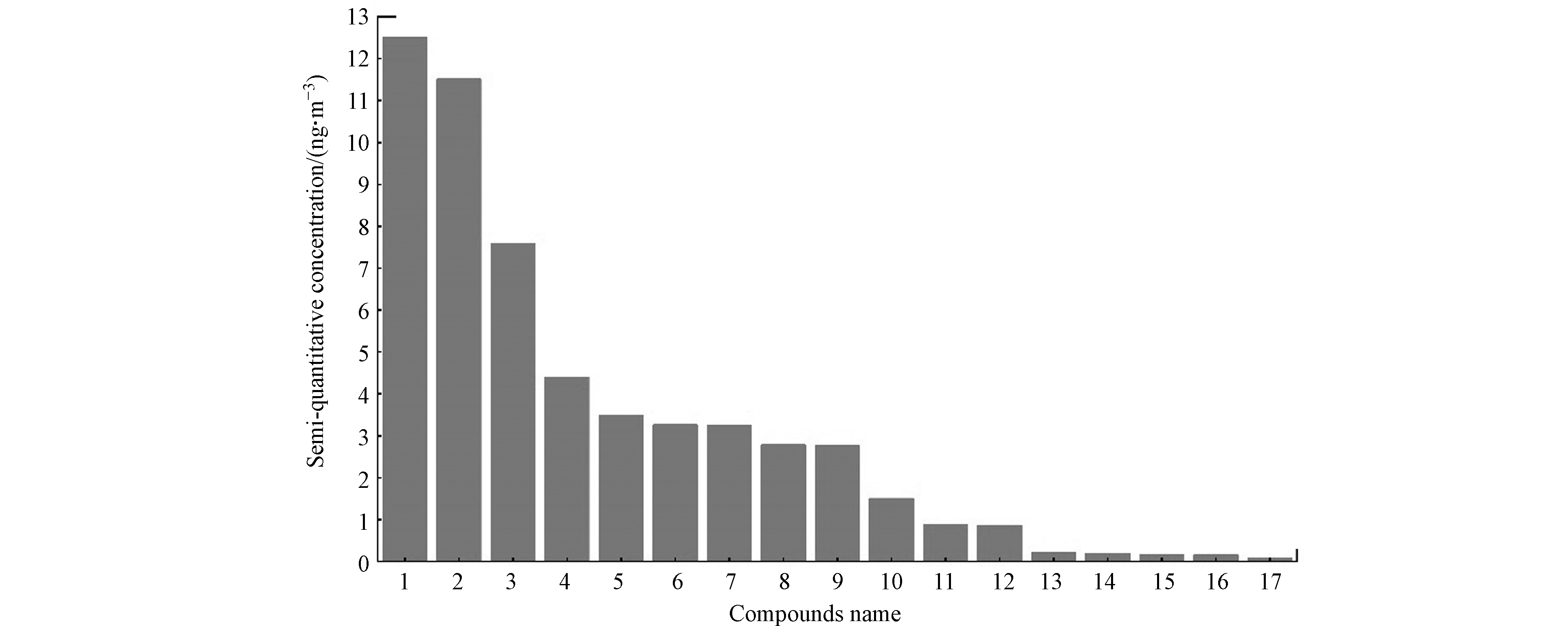-
大气环境中存在着大量人类活动所产生的有机污染物[1-2],例如多环芳烃(PAHs)、多氯联苯(PCBs)、有机氯农药(OCPs)等,这些污染物会对人体健康产生一定的危害。目前,国内外的研究主要聚焦于大气中典型污染物的浓度水平、变化特征及来源解析等方面。例如,Mina等[3]检测到地中海东部大气中PAHs、PCBs以及OCPs的浓度分别为11—18、77—93、77—140 ng·m−3;Miglioranza等[4]报道了阿根廷巴塔哥尼亚大气中PCBs及多溴二苯醚(PBDEs)的浓度分别为25 pg·m−3和1.9 pg·m−3;Vuong等[5]发现韩国大气中氯代多环芳烃及溴代多环芳烃的平均浓度分别为18.3 pg·m−3和13.2 pg·m−3。然而大气中存在许多潜在的有机污染物,单纯的基于指定目标化合物的定量分析,无法识别出大气中潜在的有毒有害污染物,而这些物质有可能对人类以及生态环境造成更严重的威胁[6-9]。因此如何从复杂的环境样品中快速准确筛查出有毒有害污染物是当前亟待解决的问题。
近年来,随着有机高分辨质谱仪器的发展,尤其是飞行时间质谱(TOF)和轨道阱(Orbitrap)的广泛应用,为环境样品中潜在污染物的识别提供了技术支持[10-14]。已有大量文献报道了土壤、废水中污染物的非靶标筛查研究,例如Domínguez等[15]采用GC-Orbitrap/MS对废水中有机污染物进行非靶标筛查,识别出PCBs、PBDEs和杀虫剂等多种有机物;Backe等[16]使用LC-QTOF/MS识别出再生水中82种化合物,包括2-甲硫基-1,3-苯并噻唑、柠檬酸三丁酯和乙酰柠檬酸三丁基等新兴污染物;Wang等[17]利用GC-QTOF/MS识别出北京某污水处理厂废水中52种可疑污染物,主要包括药物、医药中间体和阻燃剂等。此外,利用相关技术对大气中污染物的非靶标筛查工作也已开展,但相对较少,如Mazur等[18]以雪样本间接评估大气中酚类、邻苯二甲酸酯(PAEs)和亚硝胺等污染物;Cheng等[19]利用GC-TOF/MS筛选出北京PM2.5样品中17种甲基硅氧烷和18种苯基甲基硅氧烷;Zhang等[20]使用GC-QTOF/MS非靶标筛选出了大气中滴滴伊、六氯苯(HCB)和PBDEs等105种持久性有机污染物;Yang等[21]利用GC-QTOF/MS筛查出某冶金厂附近大气中的PAHs、烷基化及杂环多环芳烃衍生物等187种有机污染物。因此,加强该技术在大气污染物筛查方面的应用对解析空气中的特征污染物具有重要意义。
本文采集了北京冬季雾霾期间的单一大气样品,利用气相色谱-四极杆飞行时间质谱(GC-QTOF/MS)对大气中的有机污染物进行非靶标筛查,并开展半定量分析,目的是识别出可能存在的一些新型或潜在的有毒有害污染物,为后期准确定量分析方法的建立和环境风险评估提供技术支撑。
-
本文在北京市北四环某建筑物的楼顶采集冬季雾霾天气的单一样品,通过主动式大气采样器(SIBATA HV-700F)同时收集气态和颗粒态样品,设置流量700 L·min−1,采集时间24 h。采样之前,聚氨酯泡沫(PUF)先用加速溶剂萃取仪(DIONEX ASE 300)空提清洗,玻璃纤维滤膜(GFF)在450℃灼烧4 h。采集好的样品用铝箔纸包裹好后放入冰箱冷冻保存,等待分析。
-
实验中用到的丙酮、二氯甲烷、正己烷均为农残级,购买于Honeywell(Morristown,NJ)公司。3种同位素标准物质氘菲(Phenanthrene-D10)、氘芘(Pyrene-D10)和氘䓛(Phenacene-D12)从AccuStandard Inc.(New Haven,CT,USA)公司购买。
-
将PUF与GFF放入萃取池中,用丙酮/正己烷(V/V,1∶1)提取,温度为100℃,压力为1500 psi,预热平衡时间5 min,静态萃取时间8 min,静态萃取循环2次。收集到的提取液使用旋转蒸发仪浓缩至1—2 mL,再加入10 mL正己烷氮吹至1 mL,过0.22 µm的滤膜后转移至进样小瓶,并加入3种PAHs的同位素标准物质,上机分析。
-
样品由气相色谱-四极杆飞行时间高分辨质谱仪(Agilent 7890B,7250 GC-QTOF/MS)分析,色谱条件:Agilent 7890B,串联2根HP-5MS UI(15 m×0.25 mm ID×0.25 μm)色谱柱,流量分别为1.0 mL·min−1和1.2 mL·min−1,不分流进样,进样体积为1 μL,升温程序从60℃开始保持1 min,40℃·min−1升至120℃,再以5℃·min−1的速率升至310℃;载气为氦气。质谱条件:Agilent 7250,采用电子电离(EI)模式采集数据,离子源温度是280℃,四极杆温度是150℃,扫描速度为5 spectra·s−1,溶剂延迟3 min,质量扫描范围为45—550 amu。
-
测试数据通过两种方式进行解析,其一是基于高分辨质谱数据库进行可疑物筛查,其二是基于NIST数据库进行未知物的定性。本文涉及的高分辨质谱数据库包含1200多种化合物,主要为PAHs及其衍生物、PCBs、农药等。依据欧盟健康与食品安全总署发布的《食品饲料中农药残留分析的质量控制和方法确认指导文件》(SANTE/12682/2019)[22]设置筛查参数如下:至少存在2个匹配的精确质量数离子,质量准确度偏差小于5×10−6,保留时间偏差小于0.15 min,匹配得分大于75%。对于NIST数据库的解析结果,通过匹配得分、保留指数、精确质量数偏差、质谱图和基峰与次基峰的比值等信息进行确证。后文识别出的化合物均扣除了实验室空白的干扰。
基于添加的3种同位素标准物质的绝对量,根据未知物与其靠近的标准物质的峰面积之比进行单点校准,得到半定量浓度。
-
通过高分辨质谱数据库对样品进行可疑物筛查,共识别出78种化合物,以PAHs、多环芳烃衍生物、PAEs、有机磷酸酯(OPEs)、氯苯及有机合成中间体等为主,其比例见图1。PAHs类物质中,除了16种EPA优先控制的PAHs之外,还识别出苝、苯并[j]荧蒽、4H-环戊[DEF]菲等。多环芳烃衍生物以甲基取代为主,例如1-甲基萘、1,4-二甲基萘、2,3,5-三甲基萘、7-甲基苯并[a]蒽等。此外,识别出的典型杂环类化合物有苯并吡啶、二苯并呋喃、苯并噻唑等,见表1。
PAEs包括邻苯二甲酸二丁酯(DBP)、邻苯二甲酸二甲酯(DMP)、邻苯二甲酸二异丁酯(DIBP)、邻苯二甲酸二(2-乙基己)酯(DEHP)及邻苯二甲酸丁苄酯(BBP)等10种。作为一类常见的增塑剂,它们暴露于环境中会对人类健康产生不利的影响,例如引发生殖发育毒性及肾脏和肝脏的异常[23]。DBP是最常见的聚氯乙烯增塑剂,耐久性较差,具有生殖毒性、神经毒性及免疫毒性[24-26]。而DIBP由于毒性相对较小,现在已逐渐被用作DBP的替代品[27]。此外,在样品中共识别出磷酸三丁酯(TBP)、磷酸三(2-氯丙基)酯(TCPP)、磷酸三苯酯(TPP)等8种OPEs。OPEs兼具阻燃剂与增塑剂的功能,其中TPP被认为是无卤环保型阻燃剂,可用来替代其他的阻燃剂。
除以上物质之外,样品中还识别出敌敌畏、毒死蜱、六氯丁二烯、双苯恶唑酸、尼古丁、2,6-二异丙基萘、生物苄呋菊酯等物质。其中六氯丁二烯已被列入世界卫生组织国际癌症研究机构颁布的致癌物清单中[28],其环境风险值得关注。
样品中识别出大量PAHs的衍生物,通过提取精确质量数质谱图,能够观察到样品中是否存在其他数据库之外的同分异构体或类似物。图2展示不同数量的甲基取代萘的精确质量数色谱图,可以看出样品中包括全部的1个甲基取代的萘(1-甲基萘和2-甲基萘)。2个甲基取代的萘有几十种,本文涉及的高分辨质谱数据库中仅包含8种,样品中初步识别出5种,但在其他位置的色谱峰表明可能存在其他的同分异构体,需要借助更多信息或标准物质加以确证。3个甲基取代的萘存在相同的情况,经过质谱图的匹配、保留指数等参数,初步确定出H和I处的物质为高分辨质谱数据库之外的可疑物1,4,6-三甲基萘和2,3,6-三甲基萘。这些信息为后期更多污染物的识别和数据库的扩展提供了有力指导。
-
依据高分辨数据库的筛查只能识别出样品中包含于数据库中的有机污染物,对于数据库之外的污染物需要借助其他工具去分析。将总离子流图解卷积得到的化合物信息与NIST质谱数据库进行对比,共识别出139种典型污染物,其中有61种物质在高分辨质谱数据库之外。这些物质包括PAHs及其衍生物、增塑剂、有机合成中间体等,以及环戊烯[cd]芘、二苯并[cd,jk]芘、9-芴酮、1-甲氨基蒽醌、四甲基哌啶酮、2,6-二叔丁基-4-硝基苯酚等典型的污染物。
表1列举了大气样品中识别出的吡啶类、噻唑类、噻吩类、呋喃类、吡喃类、哌啶类、嘧啶类及吡咯类等10类杂环有机污染物。吡啶类识别出了5种,以甲基取代为主,从1个甲基到3个甲基均有发现。噻唑类识别出3种,其中2-甲硫基苯并噻唑是一种有机硫农药杀菌剂,会对水体环境造成一定的危害。呋喃类识别出二苯并呋喃和二氢猕猴桃内酯,前者会通过呼吸等途径造成基因突变、畸形等危害[29],并能够进一步氯化生成多氯二苯并呋喃。
-
污染物的环境风险与浓度直接相关,本文通过添加3种同位素标准物质,基于峰面积之比对大气样品中识别出的有机污染物进行半定量分析。识别出的有机物总浓度为288 ng·m−3,其中表1列出的杂环化合物最高(47.9 ng·m−3),占到总浓度的16.6%。具体的杂环化合物半定量浓度见表1,其中浓度最高的为噻唑类(10.3 ng·m−3),占总杂环化合物的21.5%,其次是吡咯类(9.45 ng·m−3),吡啶类(9.07 ng·m−3)及哌啶类(8.78 ng·m−3),分别占总杂环化合物的19.7%、18.9%和18.3%。对于单个污染物,浓度最高的为苯并噻唑(9.51 ng·m−3);其次是1-甲基-2吡咯烷酮、四甲基哌啶酮、尼古丁和二苯并呋喃,浓度分别为9.22、8.78、5.11、4.15 ng·m−3。
PAEs半定量浓度为44.7 ng·m−3,占总浓度的15.5%,其中浓度最高的为DBP(14.8 ng·m−3),其次是DMP和DIBP,浓度分别为9.58 ng·m−3和8.68 ng·m−3,三者分别占∑PAEs浓度的33.1%、21.5%和19.4%。OPEs的半定量浓度为1.07 ng·m−3,占总有机物浓度的0.4%,其中磷酸三辛酯(TOP)浓度最高(0.44 ng·m−3),占∑OPEs浓度的40.7%,本文报道的浓度与京津冀大气颗粒物中ΣOPEs的年平均浓度(0.36—1.07)ng·m−3[30]水平一致。
对于识别出的22种PAHs,半定量浓度为20.7 ng·m−3,占有机物总浓度的7.2%。常规监测的16种PAHs总浓度为18.1 ng·m−3,该浓度低于文献报道的北京市春节期间∑16PAHs浓度(147—157)ng·m−3[31],略高于奥运会期间∑16PAHs浓度(4.8±2.7)ng·m−3[32]。
甲基多环芳烃衍生物(MPAHs)的浓度为10.9 ng·m−3,占多环芳烃衍生物类的59.8%,同时约是∑22PAHs浓度的一半,与文献报道的越南及印度街道灰尘中比例一致(35.5%—67.3%)[33],因此它们的浓度水平不容忽视。除了MPAHs之外,9-芴酮的浓度为2.47 ng·m−3,与其母体芴的浓度水平相当(2.28 ng·m−3),但因羰基官能团的存在使它具有更强的极性与毒性,较低的饱和蒸气压也使它更容易与细颗粒物结合[34],从而进入人体肺部等器官中,造成更大的危害[35]。
除此之外,其它部分特征污染物的浓度见图3,N,N-二丁基甲酰胺的半定量浓度最高(12.5 ng·m−3),其次为乙二醇乙醚、二苯砜、肉豆蔻酸异丙酯及2,6-二叔丁基苯醌,半定量浓度分别为11.5、7.57、4.39、3.47 ng·m−3。
综上所述,大气常规监测的16种PAHs的浓度(18.1 ng·m−3)仅占总浓度的6.28%,且样品中还存在着大量其他没有识别出的污染物,因此仅仅对有限数量的指定目标物进行分析,将会低估污染天气条件下的大气环境风险。
-
本研究借助GC-QTOF/MS对大气样品中的有机污染物进行非靶标筛查,并对识别出的特征污染物进行半定量分析。样品中共识别出139种有机污染物,这些污染物以PAHs及其衍生物、PAEs为主,此外还包括多种尚未列入监管清单的杂环类化合物,如四甲基哌啶酮、1-甲基异喹啉、1-甲基-2吡咯烷酮、2-甲硫基苯并噻唑等。由半定量结果显示识别出的有机污染物总浓度为288 ng·m−3,是大气常规监测的16种PAHs浓度的15倍(18.1 ng·m−3),而杂环化合物与PAEs的浓度最高,分别是47.9 ng·m−3和44.7 ng·m−3,占总浓度的16.6%和15.5%。通过对大气样品进行非靶标筛查及半定量分析,体现了高分辨质谱技术在未知污染物识别与解析过程中的优势,为今后大气中有机污染物的解析提供了有力的技术支持。大气中潜在的污染物种类繁多,对于样品中存在的更多可疑污染物,后期将通过低能量EI、二级质谱、液相色谱-高分辨质谱等手段以及利用标准物质加以确证,从而更加全面地获取大气中潜在污染物的信息。
基于GC-QTOF/MS的大气中有机污染物的非靶标筛查及半定量分析
Non-target screening and semi-quantitative analysis of organic pollutants in the atmosphere based on GC-QTOF/MS
-
摘要: 本文借助气相色谱-四极杆飞行时间质谱仪(GC-QTOF/MS)开展了大气中有机污染物的非靶标筛查,并对识别出的特征污染物进行半定量分析。基于高分辨质谱数据库和NIST质谱数据库的匹配,样品中共识别出139种污染物,主要以多环芳烃(PAHs)及其衍生物、邻苯二甲酸酯(PAEs)为主;除此之外,还识别出多种尚未受到监管的杂环类化合物,例如苯并噻唑、四甲基哌啶酮、1-甲基-2吡咯烷酮、氧杂蒽等。识别出的有机污染物半定量浓度为288 ng·m−3,其中大气常规监测的16种PAHs的浓度是18.1 ng·m−3,仅占总浓度的6.28%。PAEs的浓度为44.6 ng·m−3,邻苯二甲酸二丁酯(DBP)的浓度最高(14.8 ng·m−3)。以含氮、氧、硫为主的杂环化合物浓度是47.9 ng·m−3,其中苯并噻唑浓度最高,为9.51 ng·m−3;其次是1-甲基-2吡咯烷酮、四甲基哌啶酮、尼古丁和二苯并呋喃,浓度分别为9.22、8.78、5.11、4.15 ng·m−3。本研究展示了高分辨质谱技术在未知物识别中的优势,并对识别出的特征污染物进行了半定量分析,其结果能够为后期污染物的风险评估提供借鉴意义。
-
关键词:
- 大气 /
- 非靶标筛查 /
- 气相色谱-四极杆飞行时间质谱 /
- 半定量分析.
Abstract: In this paper, non-target screening of organic pollutants in the atmosphere sample was carried out by gas chromatography-quadrupole time-of-flight mass spectrometry (GC-QTOF/MS) and the identified characteristic pollutants were semi-quantitatively analyzed. Based on high resolution mass spectrometry and NIST mass spectrometry database, 139 pollutants were identified, mainly by polycyclic aromatic hydrocarbons (PAHs) and their derivatives, phthalic acid esters (PAEs). In addition, a variety of unregulated heterocyclic compounds were also found, such as benzothiazole, tetramethylpiperidinone, 1-methyl-2-pyrrolidone, xanthene and so on. The semi-quantitative concentration of these organic pollutants was 288 ng·m−3, in which the concentration of 16 routinely monitored PAHs was 18.1 ng·m−3, only accounting for 6.28% of the total concentration. The concentration of PAEs was 44.6 ng·m−3, and the concentration of DBP was the highest (14.8 ng·m−3). The concentration of heterocyclic compounds mainly containing nitrogen, oxygen and sulfur was 47.9 ng·m−3, in which the concentration of benzothiazole was the highest (9.51 ng·m−3), followed by 1-methyl-2-pyrrolidone, tetramethylpiperidone, nicotine and dibenzofuran, with concentrations of 9.22, 8.78, 5.11 and 4.15 ng·m−3, respectively. In this study, the advantages of high resolution mass spectrometry in unknown screening were demonstrated, and the semi-quantitative analysis of identified potential characteristic pollutants in the atmosphere was conducted. The results were benefited for the risk management and control of potential pollutants in the future. -

-
表 1 样品中识别出的杂环化合物及其半定量浓度
Table 1. Heterocyclic compounds identified in the sample and semi-quantitative concentration
类别
Species分子式结构
Structure中文名称
NameCAS号
CAS number分子式
Formula分子式结构
Structure保留时间/min
Retention time半定量浓度/(ng·m−3)
Semi-quantitative
concentration吡啶类 
苯并吡啶 91-22-5 C9H7N 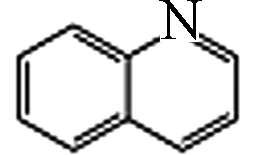
6.50 0.38 9.07 1-甲基异喹啉 1721-93-3 C10H9N 
7.69 1.14 2,5-二甲基吡啶 589-93-5 C7H9N 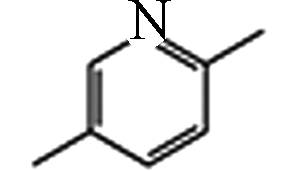
3.38 0.87 2,4,6-三甲基吡啶 108-75-8 C8H11N 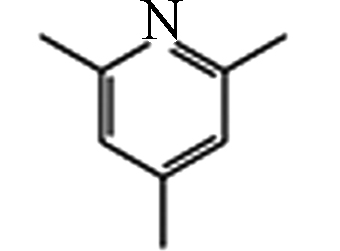
3.71 1.57 尼古丁 54-11-5 C10H14N2 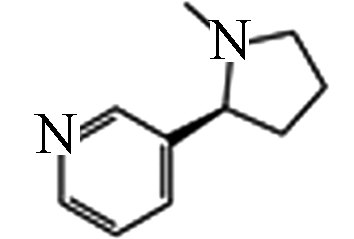
7.78 5.11 噻唑类 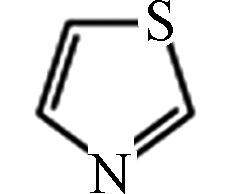
苯并噻唑 95-16-9 C7H5NS 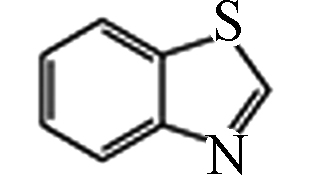
6.04 9.51 10.3 2-甲硫基苯并噻唑 615-22-5 C8H7NS2 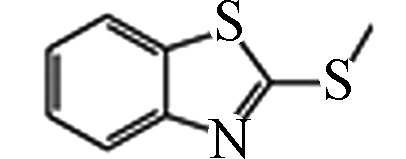
12.4 0.63 异噻唑啉酮 26172-55-4 C4H4ClNOS 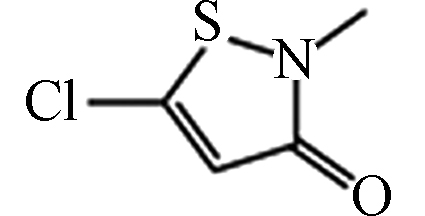
5.95 0.14 吡喃类 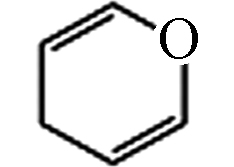
氧杂蒽 92-83-1 C13H10O 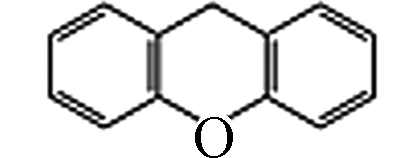
13.1 2.06 2.48 1,8-萘二甲酸酐 81-84-5 C12H6O3 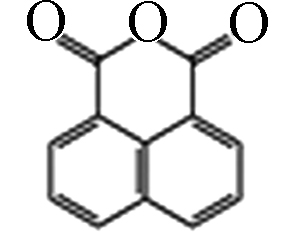
20.8 0.02 2-苯并呋喃酮 87-41-2 C8H6O2 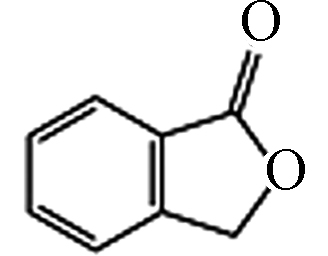
7.79 0.40 噻吩类 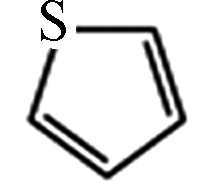
二苯并噻吩 132-65-0 C12H8S 
15.4 0.49 0.68 2,7-二甲基
苯并噻吩31317-19-8 C14H12S 
19.3 0.19 呋喃类 
二苯并呋喃 132-64-9 C12H8O 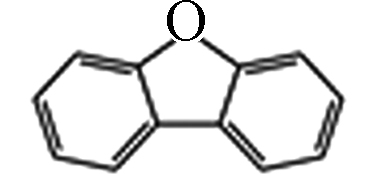
10.8 4.15 5.04 二氢猕猴桃内酯 17092-92-1 C11H16O2 
11.1 0.89 吡咯类 
1-甲基-2吡咯烷酮 872-50-4 C5H9NO 
4.01 9.22 9.45 邻苯二甲酰亚胺 85-41-6 C8H5NO2 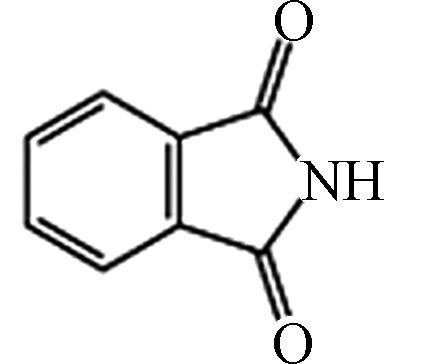
9.67 0.23 哌啶类 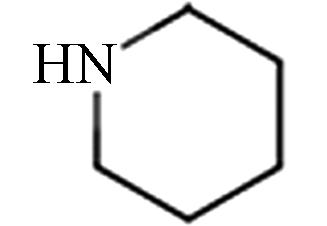
四甲基哌啶酮 826-36-8 C9H17NO 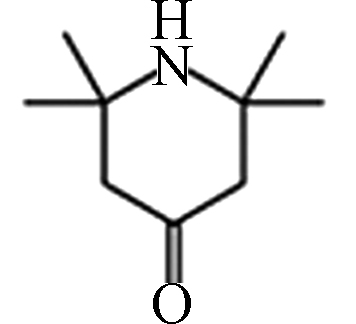
4.77 8.78 三唑类 
1,2-二氢-3H-1,2,4-三氮唑-3-酮 930-33-6 C2H3N3O 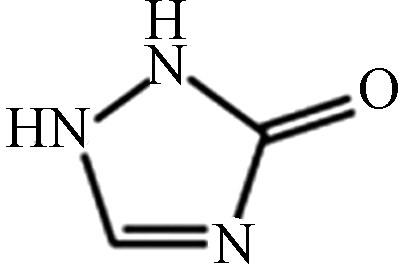
4.18 1.41 嘧啶类 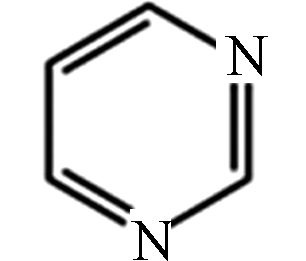
1-甲基尿嘧啶 696-11-7 C5H8N2O2 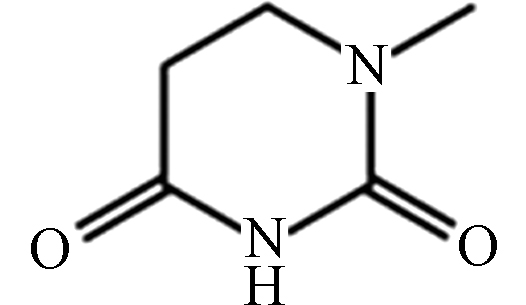
3.33 0.14 异恶唑类 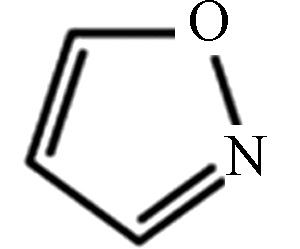
双苯恶唑酸 209866-92-2 C16H13NO3 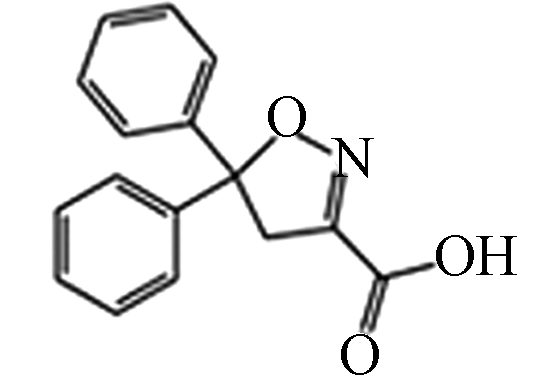
12.9 0.57 -
[1] GOLDSTEIN A H, GALBALLY I E. Known and unexplored organic constituents in the earth's atmosphere [J]. Environmental Science & Technology, 2007, 41(5): 1514-1521. [2] NOZIÈRE B, KALBERER M, CLAEYS M, et al. The molecular identification of organic compounds in the atmosphere: State of the art and challenges [J]. Chemical Reviews, 2015, 115(10): 3919-3983. doi: 10.1021/cr5003485 [3] IAKOVIDES M, APOSTOLAKI M, STEPHANOU E G. PAHs, PCBs and organochlorine pesticides in the atmosphere of Eastern Mediterranean: Investigation of their occurrence, sources and gas-particle partitioning in relation to air mass transport pathways [J]. Atmospheric Environment, 2021, 244: 117931. doi: 10.1016/j.atmosenv.2020.117931 [4] MIGLIORANZA K S B, ONDARZA P M, COSTA P G, et al. Spatial and temporal distribution of persistent organic pollutants and current use pesticides in the atmosphere of Argentinean Patagonia [J]. Chemosphere, 2021, 266: 129015. doi: 10.1016/j.chemosphere.2020.129015 [5] VUONG Q T, THANG P Q, NGUYEN T N T, et al. Seasonal variation and gas/particle partitioning of atmospheric halogenated polycyclic aromatic hydrocarbons and the effects of meteorological conditions in Ulsan, South Korea [J]. Environmental Pollution, 2020, 263: 114592. doi: 10.1016/j.envpol.2020.114592 [6] ARAKI A, SAITO I, KANAZAWA A, et al. Phosphorus flame retardants in indoor dust and their relation to asthma and allergies of inhabitants [J]. Indoor Air, 2014, 24(1): 3-15. doi: 10.1111/ina.12054 [7] JAROSIEWICZ M, DUCHNOWICZ P, WŁUKA A, et al. Evaluation of the effect of brominated flame retardants on hemoglobin oxidation and hemolysis in human erythrocytes [J]. Food and Chemical Toxicology, 2017, 109: 264-271. doi: 10.1016/j.fct.2017.09.016 [8] ZHANG Y, ZHENG X B, WEI L F, et al. The distribution and accumulation of phosphate flame retardants (PFRs) in water environment [J]. Science of the Total Environment, 2018, 630: 164-170. doi: 10.1016/j.scitotenv.2018.02.215 [9] HOLLENDER J, SCHYMANSKI E L, SINGER H P, et al. Nontarget screening with high resolution mass spectrometry in the environment: Ready to go? [J]. Environmental Science & Technology, 2017, 51(20): 11505-11512. [10] 毛佳迪, 于南洋, 于红霞, 等. 环境中有机污染物的高通量筛查技术研究进展 [J]. 环境化学, 2020, 39(1): 156-165. doi: 10.7524/j.issn.0254-6108.2019021303 MAO J D, YU N Y, YU H X, et al. Research process of the high-throughput screening for identification of environmental organic pollutants [J]. Environmental Chemistry, 2020, 39(1): 156-165(in Chinese). doi: 10.7524/j.issn.0254-6108.2019021303
[11] PENG H, CHEN C L, CANTIN J, et al. Untargeted screening and distribution of organo-iodine compounds in sediments from lake Michigan and the Arctic Ocean [J]. Environmental Science & Technology, 2016, 50(18): 10097-10105. [12] MACARRON R, BANKS M N, BOJANIC D, et al. Impact of high-throughput screening in biomedical research [J]. Nature Reviews Drug Discovery, 2011, 10(3): 188-195. doi: 10.1038/nrd3368 [13] PENG H, CHEN C L, CANTIN J, et al. Untargeted screening and distribution of organo-bromine compounds in sediments of lake Michigan [J]. Environmental Science & Technology, 2016, 50(1): 321-330. [14] ZHANG F, WANG H Y, ZHANG L, et al. Suspected-target pesticide screening using gas chromatography-quadrupole time-of-flight mass spectrometry with high resolution deconvolution and retention index/mass spectrum library [J]. Talanta, 2014, 128: 156-163. doi: 10.1016/j.talanta.2014.04.068 [15] DOMÍNGUEZ I, ARREBOLA F J, MARTÍNEZ VIDAL J L, et al. Assessment of wastewater pollution by gas chromatography and high resolution Orbitrap mass spectrometry [J]. Journal of Chromatography A, 2020, 1619: 460964. doi: 10.1016/j.chroma.2020.460964 [16] BACKE W J. Suspect and non-target screening of reuse water by large-volume injection liquid chromatography and quadrupole time-of-flight mass spectrometry [J]. Chemosphere, 2021, 266: 128961. doi: 10.1016/j.chemosphere.2020.128961 [17] WANG Y J, GAO W, WANG Y W, et al. Suspect screening analysis of the occurrence and removal of micropollutants by GC-QTOF MS during wastewater treatment processes [J]. Journal of Hazardous Materials, 2019, 376: 153-159. doi: 10.1016/j.jhazmat.2019.05.031 [18] MAZUR D M, DETENCHUK E A, SOSNOVA A A, et al. GC-HRMS with complementary ionization techniques for target and non-target screening for chemical exposure: Expanding the insights of the air pollution markers in Moscow snow [J]. Science of the Total Environment, 2021, 761: 144506. doi: 10.1016/j.scitotenv.2020.144506 [19] CHENG Z, QIU X H, SHI X D, et al. Identification of organosiloxanes in ambient fine particulate matters using an untargeted strategy via gas chromatography and time-of-flight mass spectrometry [J]. Environmental Pollution, 2021, 271: 116128. doi: 10.1016/j.envpol.2020.116128 [20] ZHANG X M, SAINI A, HAO C Y, et al. Passive air sampling and nontargeted analysis for screening POP-like chemicals in the atmosphere: Opportunities and challenges [J]. TrAC Trends in Analytical Chemistry, 2020, 132: 116052. doi: 10.1016/j.trac.2020.116052 [21] YANG L L, WU J J, ZHENG M H, et al. Non-target screening of organic pollutants and target analysis of halogenated polycyclic aromatic hydrocarbons in the atmosphere around metallurgical plants by high-resolution GC/Q-TOF-MS [J]. Environmental Sciences Europe, 2020, 32(1): 1-14. doi: 10.1186/s12302-019-0282-1 [22] EU. SANTE/12682/2019 Method Validation & Quality Control Procedures for Pesticide Residues Analysis in Food & Feed[S]. 2019. [23] FUJII M, SHINOHARA N, LIM A, et al. A study on emission of phthalate esters from plastic materials using a passive flux sampler [J]. Atmospheric Environment, 2003, 37(39/40): 5495-5504. [24] WANG X Q, HAN B, WU P F, et al. Dibutyl phthalate induces allergic airway inflammation in rats via inhibition of the Nrf2/TSLP/JAK1 pathway [J]. Environmental Pollution, 2020, 267: 115564. doi: 10.1016/j.envpol.2020.115564 [25] CHEN H, CHEN K, QIU X C, et al. The reproductive toxicity and potential mechanisms of combined exposure to dibutyl phthalate and diisobutyl phthalate in male zebrafish (Danio rerio) [J]. Chemosphere, 2020, 258: 127238. doi: 10.1016/j.chemosphere.2020.127238 [26] CHENG J J, WAN Q, GE J, et al. Major factors dominating the fate of dibutyl phthalate in agricultural soils [J]. Ecotoxicology and Environmental Safety, 2019, 183: 109569. doi: 10.1016/j.ecoenv.2019.109569 [27] YOST E E, EULING S Y, WEAVER J A, et al. Hazards of diisobutyl phthalate (DIBP) exposure: A systematic review of animal toxicology studies [J]. Environment International, 2019, 125: 579-594. doi: 10.1016/j.envint.2018.09.038 [28] 王尧天, 张海燕, 史建波, 等. 六氯丁二烯分析方法研究进展 [J]. 色谱, 2021, 39(1): 46-56. doi: 10.3724/SP.J.1123.2020.05019 WANG Y T, ZHANG H Y, SHI J B, et al. Research progress on analytical methods for the determination of hexachlorobutadiene [J]. Chinese Journal of Chromatography, 2021, 39(1): 46-56(in Chinese). doi: 10.3724/SP.J.1123.2020.05019
[29] LIU Y L, HU H Y, ZANAROLI G, et al. A Pseudomonas sp. strain uniquely degrades PAHs and heterocyclic derivatives via lateral dioxygenation pathways [J]. Journal of Hazardous Materials, 2021, 403: 123956. doi: 10.1016/j.jhazmat.2020.123956 [30] ZHANG W W, WANG P, ZHU Y, et al. Occurrence and human exposure assessment of organophosphate esters in atmospheric PM2.5 in the Beijing-Tianjin-Hebei region, China [J]. Ecotoxicology and Environmental Safety, 2020, 206: 111399. doi: 10.1016/j.ecoenv.2020.111399 [31] 董小艳, 王琼, 杨一兵, 等. 2017年春节期间北京市城区和郊区大气PM2.5及其中多环芳烃的污染特征 [J]. 环境化学, 2018, 37(10): 2191-2198. doi: 10.7524/j.issn.0254-6108.2017122503 DONG X Y, WANG Q, YANG Y B, et al. Characterization of ambient PM2.5 and PAHs during 2017 Spring Festival in urban and suburb areas of Beijing [J]. Environmental Chemistry, 2018, 37(10): 2191-2198(in Chinese). doi: 10.7524/j.issn.0254-6108.2017122503
[32] WU Y, YANG L, ZHENG X, et al. Characterization and source apportionment of particulate PAHs in the roadside environment in Beijing [J]. Science of the Total Environment, 2014, 470/471: 76-83. doi: 10.1016/j.scitotenv.2013.09.066 [33] TUYEN L H, TUE N M, TAKAHASHI S, et al. Methylated and unsubstituted polycyclic aromatic hydrocarbons in street dust from Vietnam and India: Occurrence, distribution and in vitro toxicity evaluation [J]. Environmental Pollution, 2014, 194: 272-280. doi: 10.1016/j.envpol.2014.07.029 [34] LUI K H, BANDOWE B A M, HO S S H, et al. Characterization of chemical components and bioreactivity of fine particulate matter (PM2.5) during incense burning [J]. Environmental Pollution, 2016, 213: 524-532. doi: 10.1016/j.envpol.2016.02.053 [35] BANDOWE B A M, MEUSEL H, HUANG R J, et al. PM2.5-bound oxygenated PAHs, nitro-PAHs and parent-PAHs from the atmosphere of a Chinese megacity: Seasonal variation, sources and cancer risk assessment [J]. Science of the Total Environment, 2014, 473/474: 77-87. doi: 10.1016/j.scitotenv.2013.11.108 -



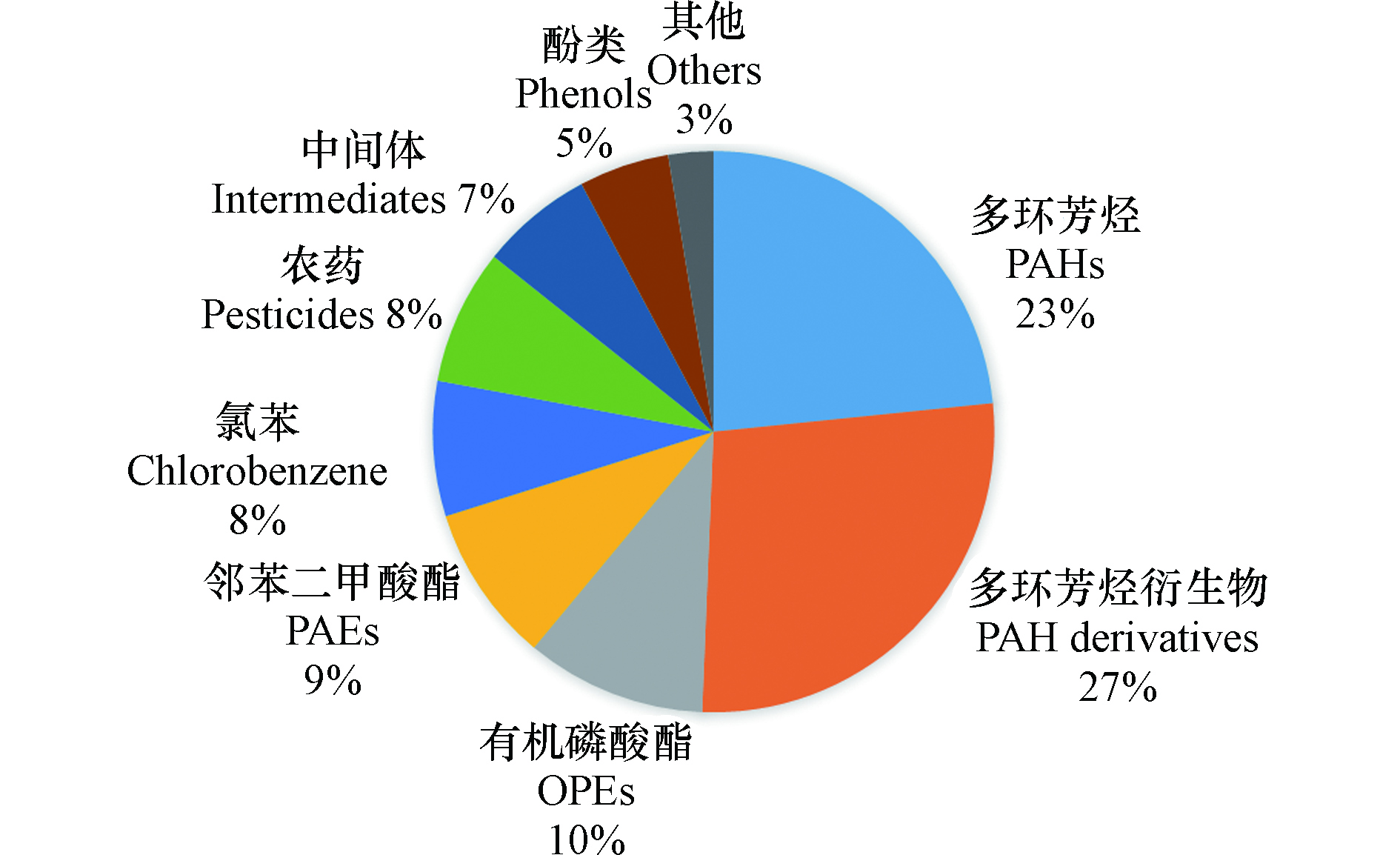
 下载:
下载:
